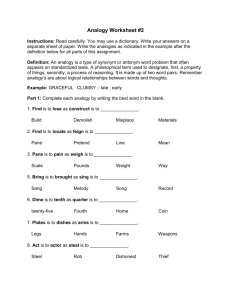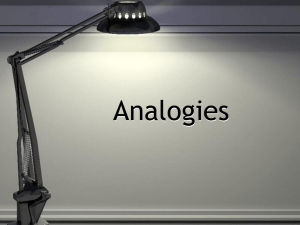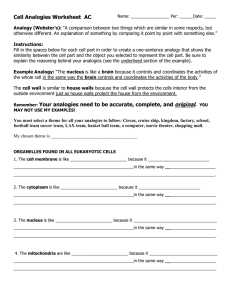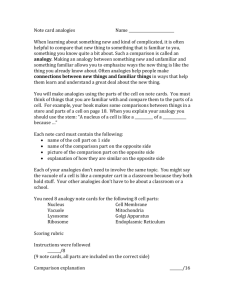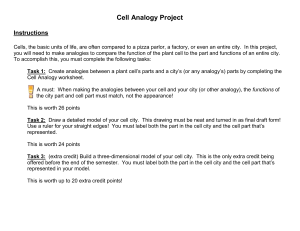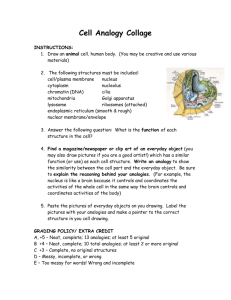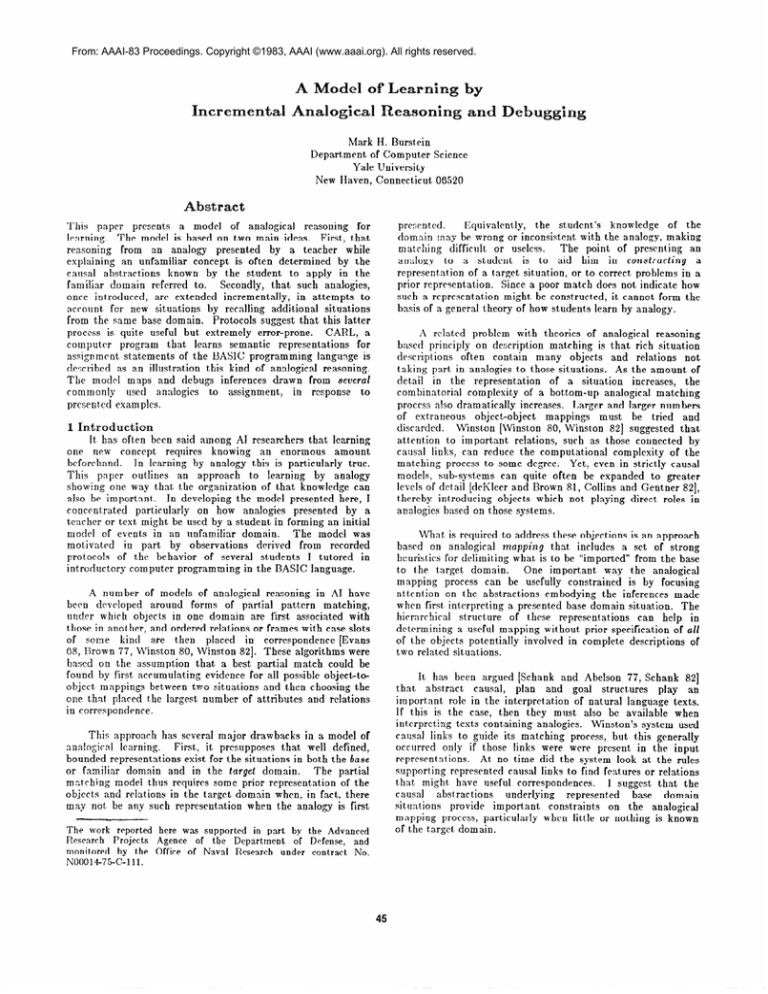
From: AAAI-83 Proceedings. Copyright ©1983, AAAI (www.aaai.org). All rights reserved.
A Model
Incrernenfal
of Learning
Analogical
Reasoning
Mark H. Burstein
Department
of Computer
Yale University
New Haven, Connecticut
by
and Debugging
Science
08520
Abstract
Equivalently,
the st,udcnt’s
knowledge
of the
prcscntcd.
tiomnin lnay be wrong or inconsistent
with the analogy,
making
The point of presrnting
an
matching
difficult
or useless.
ana!oay
to a student
is to aid him in coTzatrerc2ing
a
representation
of a target situation,
or to correct problems
in a
prior representation.
Since a poor match does not indicate how
such a representation
might be constructed,
it cannot form the
basis of a general theory of how students
learn by analogy.
a mode!
of analogical
reasoning
for
This
paper
presents
learning.
The mode! is based on two main ideas.
First, that
from
an analogy
presented
by a teacher
while
reasoning
explaining
an unfamiliar
concept
is often determined
by the
causal
abstractions
known
by the student
to apply
in the
Secondly,
that such analogies,
familiar
domain
referred
to.
once introduced,
are extended
incrementally,
in attempts
to
ncrount,
fcr new situations
by recalling
additional
situations
from the same base domain.
Protocols
suggest that this latter
process
is quite useful but extremely
error-prone.
CARL,
a
semantic
representations
for
computer
program
that
learns
assignment
statements
of the BASIC programming
langurrge
is
dcricribcd
as an illustration
this kind of analogical
reasoning.
The motlr!
maps and debugs
inferences
drawn
from several
commonly
used
analogies
to assignment,
in response
to
prcsentct!
examples.
A related
problem
with theories
of analogical
reasoning
based principly
on description
matching
is that rich situation
descriptions
often
contain
many
object,s
and re!at.ions
not
taking part in analogies
to those situations.
As the amount
of
detail
in the representation
of a situation
increases,
the
combinatorial
complexity
of a bottom-up
analogical
matching
process also dramatically
increases.
Larger and larger numbers
of extraneous
object-object
mappings
must
be tried
and
Winston
[Wmston
80, Winston
821 suggested
that
discarded.
att,ention
to important
relations,
such as those connected
by
causal links, can reduce the computational
complexity
of the
matching
process to some degree.
Yet, even in strictly
causal
sub-systems
can quite often be expanded
to greater
models,
!evc!s of detail [deK!eer and Brown 81, Collins and Gentner 821,
thereby
introducing
objects
which not playing
direct roles in
analogies
based on those systems.
It has often been said among AT researchers
that learning
new concept
requires
knowing
an enormous
amount
beforchanc!.
In learning
by ana!ogy
this is particularly
true.
This
pnper
outlines
an approach
to learning
by analogy
showing one way that the organization
of that knowledge
can
also be importnnt.
In developing
the model presented
here, I
concentrated
particularly
on how analogies
presented
by a
teacher or text might be used by a student in forming an initial
The model was
mode! of events in an unfamiliar
domain.
motivated
in part
by observations
derived
from
recorded
protocols
of the behavior
of several
students
I tutored
in
introductory
computer
programming
in the BASIC language.
one
What. is required to address these objections
is an approach
based on analogical
mappkng
that
includes
a set of strong
heuristics
for delimiting
what is to be “imported”
from the base
to the target
domain.
One important
way the analogical
mapping
process
can be usefully
constrained
is by focusing
attention
on the abstractions
embodying
the inferences
made
when first interpreting
a presented
base domain situation.
The
hierarchical
structure
of these representations
can help in
determining
a useful mapping
without
prior specification
of all
of the objects potentially
involved in complete
descriptions
of
two related situations.
A number
of models of analogical
reasoning
in -41 have
been drvcloped
around
forms
of partial
pattern
matching,
under which objects
in one domain
are first associated
with
those in another,
and ordered relations
or frames with case slots
are then
placed
in correspondence
[Evans
of some
kind
08, Hrown 77, M’inston 80, Winston 821. These algorithms
were
based on the assumption
that a best partial
match could be
found by first accumulating
evidence for al! possible object-toobject mappings
between two situations
and then choosing the
one that placed the largest number of attributes
and relations
in correspondence.
It has been argued [Schank
and Abelson
77, Schank
821
that
abstract
causal,
plan
and
goal
structures
play
an
important
role in the interpretation
of natural
language
texts.
If this is the case, then they must also be available
when
int,erprcting
texts containing
analogies.
Winston’s
system used
causal links to guide its matching
process, but this generally
occurred
only if those links were were present
in the input
representations.
At no time did the system look at the rules
supporting
represented
causal links to find features or relations
that. might, have useful correspondences.
I suggest
that the
causal
abstractions
underlying
represented
base
domain
situations
provide
important
constraints
on the analogical
mapping
process, particularly
when little or nothing
is known
of the tarcot,
OG domain.
Tlris approach
has several major drawbacks
in a mode! of
anaIn,cical
Icarning.
First, it presupposes
that we!! defined,
bounded
representations
exist for the situations
in both the base
The partial
or familiar
domain
and in the target domain.
mz:trhing
mode! thus requires some prior representation
of the
objects and relations
in the target domain when, in fact, there
may not be any such reprcseutation
when the analo,gy is first
The work reported
rLpscarch Projects
monitored
by the
here was supported
in part by the Advanced
Agence of the Department
of Defense, and
Office of Naval Research under contract
No.
NOO014-75-C-111.
45
Many aspects of this approach
to analogical
learning
are
illustrated
the behavior
of a computer
program,
CARL, that
attempts
to learn about various kinds of assignment
statements
by building
conceptual
models drawn
from several different
CARL makes a number
of the errors I found my
analogies.
students
made as they tried to use the same analogies
[I3urstein
811. The following is the English equivalent
of one portion of a
dialogue
that
CARL
engages
in (actual
inputs
are
in
Conceptual
Dependency
[Schank and Abelson 771) :
:> The computer
remembers
a number by putting it
in a variable.
variable
A
>>
To
put
the
number
>>
liow do
you
get
Type
Suppose
>>
P:ow what's
>>
6
No,
CARL:
is
the
>>
Suppose
Now
>>
>>
>>
variable
to
named
remember
x type
the
number
'X=5'.
9?
9
'X=6'.
variable
in X and
9
replaces
I type
is
the
is
'Y=5'
in the
X?
in X
6
in X.
and
then
variable
'X=Y'.
X?
in X
it means
put
the
number
in Y
into
X.
OK
what's
in the
variable
Y?
analogy
to
Nothing.
Guess
CARL:
>>
Y
Now
CARL:
in the
computer
type
in the
what's
No,
CARL:
5
the
OK
>>
CARL:
I then
5
again.
is
in Y
The hydrogen
(by
atom is like the solar system.
flows through
a wire like water through
a pipe.
a box.
X = 9
>>
CARL:
like
Theory
The
mapping
algorithm
developed
for
CARL
was
influenced
by a model of analogical
reasoning
called structtsre
mnpping,
developed
for a series
of psychological
studies
Gcntner
[Gentner
82, Gentner
and Gentner
821. This model
was used to describe the effects of human reasoning
when given
analogies,
such as those
below.
scientific
or “explanatory”
[Gentner 821
Electricity
>>
CARL:
is
2 An Initial Structure Mapping
algebraic
equality)
The mapping
algorithm
Gentner
proposed
for reasoning
from
analogies
of this type circumvented
some
of the problems
with
match-driven
models
in that
it did not require
a prior
However,
it was
representation
of the target
domain.
underspecified
as a cognitive
process model.
By her model,
first-order
relations,
or predicates
involving
several objects or
concepts,
are mapped identically from one domain to the other
After
under
a prespecified
objectcobject
correspondence.
been
used
to
relate
identical
first-order
relations
have
corresponding
objects
in a ta.rget
situation,
second-order
predicates,
such as causal links between
first-order
relations,
While this does suggest a way to map new
were also mapped.
structures
into an unfamiliar
domain,
it does not give a good
account
of how corresponding
objects are first identified,
nor
does it constrain
which relations
are mapped.
It also does not
allow for mappings
between non-identical
relations,
which I will
argue is often necessary.
Correct.
CARL:
OK
In this example,
CARL is first introduced
to assignment
primarily
in terms of an often used analogy
between variables
and boxes. The initial statement
of the analogy includes both a
statement
of the principle
object
class correspondence
(i.e.
box::variable),
and an example
of an assignment,
described
in
terms of a parallel “box domain”
situation.
These
statements
taken
together
provides
CARL
with
enough information
to form an initial description
of the relation
between variables
and numbers formed by assignment,
principly
that this new relation
is “like” physical
containment
in some
specific ways.
CARL concludes
that the relation
between the
variable
X and the number
5 results
from the assignment
act,ion requested
by typing
“X=5”,
in the way “the object is in
the box” results from the action
“put an object
in a box”.
Most attributes
of boxes, physical
objects,
and many possible
relations
between
the two are completely
ignored
in this
process.
Other
consequences
of this
analogy,
including
many
erroneous
ones, are discovered
during further
exercises
in the
new domain.
As new examples
are presented,
other, related
situations
are retrieved
from CARL’s
memory
of the “box”
domain,
the mapping
process is repeated,
using the object and
predicate
correspondences
formed
initially.
Errors
are
discovered
and corrected
either by explicit statements
of the
tutor,
or, when possible,
by the use of internally
generated
alternative
hypotheses.
CARL uses several other analogies
in
this process, including
the similarity
between
assignment
and
equality,
and the common
belief that computer
actions mimic
human
actions.
As in the above example,
secondary
analogies
are used to discover
alternate
hypotheses
about the effects of
statements
when errors are detected.
When
a class of assignment
statements
is successfully
modeled by a structure
formed in the mapping
process, parsing
and generation
rules are also associated
with the new structure.
In this way, CARL learns to manipulate
most common forms of
assignment
statements.
The need to constrain
the set of relations
mapped
can be
seen from Gentner’s
representation
of the solar system model,
and the mapping
that her system suggests to a model for the
atom.
In that representation,
the sun is related to a planet by
the predicate
HOTTER-THAN,
as well as the predicates
ATTRACTS,
REVOLVES-AROUND
and MORE-MASSIVE
TIIAN,
three
relations
which
are causally
linked
in the
description
of the orbiting
system.
Gentner
claimed that the
IIOTTER-THAN
relation
was not mapped
to the atomic
model, in accord with most people’s intuitions.
However,
her
formal mapping
algorithm
could not predict this.
Many other
attribute
comparisons,
such as RRIGIITER-TIIAN,
could also
have
been present
in a description
of the solar
system.
Presumably,
these rela,tions would not be mapped either.
The explanation
given for this phenomenon
was in terms
of a general
condition
on the mapping
process
she termed
systemnticity.
This condition
is essentially
that “predicates
are
more likely to be imported
into the target if they belong to a
system
of rohercnt,
mutually
constraining
relationships,
the
others of which are mapped.”
[Gentner and Centner
821
In CARI,, this condition
appears as the top-down
heuristic
delimiting
the relations
considered
for mapping.
When
a
causally
connected
structure
is in memory
to describe
a base
domain
situation,
only relations
taking
part in that structure
are considcrcd
for mapping.
Within
that
set of relations,
simple attribute
comparisons
like IIOTTER-THAN,
LARGERTIIAN are not mapped
if no corresponding
attributes
can be
found in the target domain.
The result of mapping
a causallyconnected
structure
under these conditions
is a new, parallel
causal structure
cbaracterilin
g the target
example.
Objects
in
the target example are made to fill roles in that structure
using
stated
object
correspondences
between
the domains
when
available,
and otherwise
by their appearance
in roles of actions
and
other
relations
with
objects
that
do have
known
correspondences.
Thus, in the analogy
between variables
and
boxes,
an indirect
correspondence
is formed
between
the
situational
role of a physical object that is INSIDE a box, and a
number assigned to a variable.
This causally
directed
mapping
process thus forms new
structures
in domains where none existed before, while allowing
relations
to be mapped
with some consideration
of what is
known of the objects and relations
in the target domain.
The
process
is also top-down
in that classes of objects
are only
placed in correspondence
across domains explicitly by statement
of the
teacher,
or,
indirectly,
during
mapping
by the
appearance
of an object in a role of the target structure
where
a different
object
was described
in same role in the base
domain structure.
3 Mappings
between non-identical
relations
Another
problem
with
both
Winston’s
and Gentner’s
models of analogical
reasoning
can be found in the claim that
all relations
are mapped
“identically”
from
one situation
Winston’s
matcher
embodied this claim
description
to another.
since it only found correspondences
between identical predicates
This condition
may apply in analogies
in two representation.
where the domains
overlap
or are closely related,
as in the
standard
geometric
analogies
dealt with by Evans, and many
scientific
analogies.
However, it is much too strong a claim in
general.
When
analogies
are formed
between
physically
realizable
situations
and purely
abstract
ones, like those of
mathematics
or computer
programming,
it is impossible
to
maintain
the “identical
predicate”
mapping
position.
Probably
the most important
thing implied by the analogy
between
boxes and variables
is that variables
can “contain”
things.
That is, the relationship
that exists between a box and
an object
inside the box is, in some ways, similar
to the
relationship
between a variable and the number associated
with
that variable.
The important
inference that must be preserved
in the mapping
is that since one can put things in boxes, then
t,here must be a way to “puut” numbers
‘%?I” variables
as well.
The problem
from the standpoint
of Gentner’s
model, is
that the relationship
which gets mapped from the “box world”
“computer
world”
is precisely
that
of physical
to the
That is, the interprela.tion
that results
from
rontainment.
copying
this relation
into the programming
domain
is that a
number is physically
INSIDE a variable.
Unfortunately,
not all
of the inferences which the relation INSIDE takes part in apply
to numbers
“in” variables.
For example,
there is no primitive
action in BASIC that corresponds
precisely to the action “take
out of”. CARL determines
that target relation may have some
differences
from the physical
relation
INSIDE by noting that
numbers
violate a typical constraint
on the object slot of the
INSIDE relation.
Since a number is not a physical object, it is
tiot in the class of objects
normally
“contained”
in other
Thus, the relation
suggested
between
variables
and
objects.
numbers
cannot
be the standard
notion of containment,
but
instead
must
be some
(as yet
undetermined)
analogical
extension of that relationship.
When an attempt
to map a relation directly results in such
a constraint
violation,
a virtual relation is formed in the target
domain
tbat is a “sibling” of the corresponding
base domain
relation,
or an ancestor
at some higher
level in is-a the
hierarchy
of known
relational
predicates.
The constraints
placed
on the roles in new virtual
relations
are determined
primarily
from the classes of the objects related in the target
domain
example.
Thus, from the analogy
to boxes, a new
prctlicate
INSIDE-VARIABLE
is formed to relate variables
and
“contents”,
initially
constrained
to
be
numbers.
their
Inferences
are associated
with this new relation
as they are
mapped
from
the
base
domain,
learned
successfully
indcpcntlcntly
in the new domain,
or inherited
from other
,analogics.
4 Overview
of CARL’s
analogical reasoning
process
CARL develops
simple causal or infcrenti31
structures
in
the target
domain
by retrieving
structures
in memory
for the
familiar
domain,
and adapting
them to the new domain,
using
a top-down
mappiog
process that preserves the causal/temporal
links explicitly
specified
in those structures.
In the retrieval
process, base domain objects arc substituted
for target domain
objects whcu those correspondences
can bc determined
from the
prcscntcd
description
of the analogy.
The mapped
predicates
are subject
to transformation
within an abstraction
hierarchy,
as described
above.
Subsequent
use of the same ana]o,gy may
either be for the purpose
of mapping
a related
structure
- a
related
type of action
situation,
or a more context-specific
version of the originally
mapped structure
- using t,he mapping
developed
initially,
or an extension
of that mapping
to inciude
new predicates.
The structure
first mapped
when CARL is given the box
analogy
is a simple conceptual
description
of the action
of
putting
an unspecified
object
in a box, together
with the
standard
rcsnlt of that action, that the object is then INSIDE
that Lox.
The result relation
INSIDE is transformed
in the
mapping
process to a new relation which I will refer to here as
INSIDE-VRFKABLE.
The action
PTRANS
representing
a
change
of physical
location
is replaced
with the more general
predicate
TRANS,
indicating
any state change,
and causally
connected
to the result, that the OBJECT
of the TRANS
is
INSIDE-VARIABLE
after
the
action
is completed.
The
standard
precondition
on putting
an object in a box, that the
object
fit in the box, is ignored
since neither
variables
nor
numbers are known to have a physical SIZE.
5 Incremental analogical reasoning for Beaming
Even when analogies
are based on simple
actions,
the
specific inferences to be made may vary considerably
depending
on the context
in which th- action
occurs.
For example,
throwing
a rock at a brick wall and throwing
one at a glass
window
are known
to have
very
different.
consequences.
Tbough
an analogy
to a thrown
rock might imply indirectly
that the specific inferences
valid in such alternate
contexts
will
apply in some target
domain
situation,
in practice
each such
situation
must be explored
to determine
the true extent
to
which the analogy
is valid.
Extending
analogies
in this fashion
is an error-prone
process
as ofttcn as it is useful.
CARL
attempts
to extend
an analogy
to such
alternate-context
inferences
only as they arc required to interpret
new situations
in the target domain, making a number of errors in the process.
In the protocols
I examined,
these errors appeared
only
when the context
in the target domain
made them potentially
useful inferences.
For example, when a statement
like “X=Y”
was first introduced,
it was necessary to explain that this meant
X was given the value that Y had previously.
One student
then inferred
that Y was must contain
“nothing”,
since that
was what happened
with boxes.
Finding
and correcting
these
special-case
errors in the inference rules mapped is treated
here
process
that
requires
observation
and
as an incremental
consideration
of a number of examples in t,be new domain.
This
behavior
is modeled
in CARL
by retrieval
and
mapping
of related causal structures
from a base domain
(the
box domain in this case). One interpretation
found for “X=Y”
in terms of the box analogy is that it is like moving an object
from
one box to another.
Information
saved
about
the
mapping
of the prototype
“put an object in a box’ is used both
in finding
the structure
representing
this more specific action
and subsequently
to map it back to the programming
domain.
organization
for knowledge
of simple
CARI,‘S memory
action-based
domains
involving
familiar
objects
is in part an
extension
of an object-based
indexing
system
developed
by
78, Lehnert
and Burstcin
791 for natural
Lchnrrt
[I,thncrt
So that CARL can retrieve a variety
language
processing
tasks.
of special case situations,
the retrieval
process was augmented
using a discrimination
system as in the specification
hierarchy
model of episodic
memory
used by Lebowitz
and Kolodner
[Lcbowitz
80, Kolodner
80).
Precondition/result-based
indexing was also added so that actions and simple plans could
be retrieved
in response
to requests
to achieve specific goals.
Any of these forms of indexing
may be used in finding
a
For familiar
domains,
the system
suitable
structure
to map.
assumes
a large set of fairly
specific
generalized
situations
exists, detailing
the causal inferences
expected in each case. As
an example,
CARL contains
the following structures
describing
the effects of some simple actions involving containers.
Sltuatlons
using BOX as a CONTAINER:
(PUT-IN-BOX
OEJ-IN-BOX
TAKE-FROI~-BOX)
L
1. Brown, Richard.
Use of Analogy
Tech. Rcpt. 403, M.I.T.
A.I. h4emo,
to Achieve New Expertise.
hlay, 1977.
2. Burstein,
Mark Ii. Concept Formation
through
the
Interaction
of h4ultiple hlodels.
Proceedings
of the Third
Annual Conference
of the Cognitive
Science Society, Cognitive
Science Society, August,
1981, pp. 271-274.
3. Collins, Allan and Gentner,
D&e.
Constructing
Mental Models.
Proceedings
of the Fourth Annual
of the Cognitive
Science Society, Cognitive
Science
August,
1982, pp. 86-89.
Runnable
Conference
Society,
4. de Kleer, J. and Brown, ,J. S. hlental h4odels of Physical
h4echanisms
and their Acquisition.
In CognitPtre Skills and
Their
Acgele’sition, Anderson,
John R., Ed.,Lawrrnce
Ehrlbaum
and Assoc., IIillsdale, NJ, 1981, pp. 285-309.
c
TRANSFER-OBJ-BETWEEN-BOXES
1
PUT-BOX-IN-BOX
b
I
PUT-MORE-IN-BOX
SWAP-OBJ-IN-BOXES
netuork
for things
5. Evans,
Geometric
Information
Cambridge,
Part of the
specialization
References
Thomas G. A Program
for the Solution of
Analogy Intelligence
Test Questions.
In Sernatztic
Processing,
Marvin L. Minsky, Ed.,M.I.T.
Press,
Massachusetts,
1968.
“INSIDE”
Once
an initial
mapping
is formed
from
the causal
structure
PUT-IN-BOX,
specializations
of t,hat structure
are
available
when new examples
presented
to CARL.
Also, once
the containment
relation
is formed for variables,
expectations
are established
for bhe other
“primitive”
situations
involving
containers.
Thus, from the fact that variables
can “contain”
numbers,
it is espected
that
they
can be “put in” and
“removed”.
8. Gcntncr,
Dcdrc.
Structure
Mapping:
d4 Thecretical
Framework
for Analogy and Similarity.
Proceedings
of the
Fourth Annual Conference
of the Cognitive
Science Society,
Cognitive
Science Society, August, 1982, pp. 13-15.
7. Gentncr,
D. and Gentner,
D. R. Flowing waters or teeming
crowds: hlental models of electririty.
In Mental Models,
Gentner,
D. and Stevens, A. L., Ed.,Lawrence
Erlbaum
Associates,
Hillsdale, New Jersy, 1982.
The result of mapping
these additional
structures
is the
formation
of a corresponding
set of structures
for assignment
statements.
Many of these new structures
contain
erroneous
inferences,
which are “debugged”
locally, by observation
of the
actual results entailed,
or simply thrown
out. Information
for
recognizing
each structure,
in this case parsing and generation
information
for program
statements,
is attached
to each new
structure
during the analysis of the examples that caused them
Corrections
propagate
downward
from the
to be mapped.
initial prototype
formed, to the variants
mapped
subsequently.
Thus, for example, the fact that ‘X=5’ removes old values of X
also automatically
applies to ‘X=Y’.
8. Kolodner,
Janet L. Retrieval
and Organizational
Strategies
in Conceptual
Memory:
A Computer
hlodel.
Tech. Rept. 187,
Yale University.
Department
of Computer
Science, 1980. Ph.D.
Dissert,ation
In developing
CARL, I have been concerned
with a number
of related
issues in the learning
of basic concepts
in a new
domain
by a combination
of incremental
analogical
reasoning
from multiple
models.
I have tried here to motivate
the need
for top-down
use of known abstractions
in this process. This
was found
to be necessary
both
to limit
the analogical
reasoning
required
to form some initial concepts
in the new
domain,
and to allow for incremental
debugging
of the many
errors that, can result from the use of analogies.
The process
described
here is heavily teacher-directed,
but allows for fairly
rapid
development
of a working
understanding
of basic
concepts in a new domain.
11. Lchnert,
W.G.
and Burstein,
h4.H. The Role of Object
Primitives
in Natural
Languag,
Processing.
Prorcedings
of the
Sixth International
Joint Conference
on .4rtificial Intelligence,
IJCAI, August, 1979, pp. 522-524.
Acknowledgements:
I would like to thank Dr. Chris Riesbeck and
Larry Birnbaum for many helpful comments on drafts of this paper.
9. Lebowitz, M. Generalization
System
Integrnted Understanding
LJnivcrsity,
October
1980.
and Memory in an
. Ph.D. Th., Yale
10. Lehnert, W. G. Representing
Physical
Memory.
Tech. Rept. 131, Yale I’nivcrsity.
Computer
Science , 1978.
Objects in
Department
of
12. Schank, R.C.. Dynamic memory:
A theory of learning
in computers and people. Cambridge
University
Press, 1982.
1.3. Schank, R.C. and Abelson, R.. Srr%‘pts, Plans, Goals
Understanding.
Lawrence
Erlbaum
Associates,
Iiillsdale,
Jersy, 1977.
and
New
14. Winston,
details.
Tech.
P. Learning
and reasoning
by analogy: the
Rept. 520, M.I.T. A.I. hlemo, A4ay, 1980.
15. Winston,
and exercises.”
P. n Learning
new principles
from precedents
Artificial Intelligence 19 (1982), 321-350.

